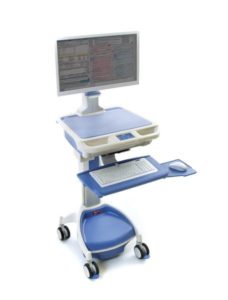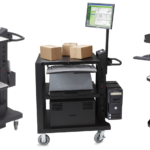Seven questions you can ask to find out which mobile computing workstations will work best in your facility.
As hospitals adopt and expand mobile computing strategies, power systems are critical to ensuring caregivers access the information they need, shift after shift, where it matters most – at the point of care. Details about run time and recharge time, among others, impact workflow and patient care. The marketplace is filled with competing claims about which factors matter most – a debate influenced largely by the technical specifications of a given company’s products.
For example, there is much attention on cycle life – the number of times a battery can be recharged. Workstation providers compete to see who can claim the biggest number and boast of capabilities for 8,000 cycles or more. The numbers look impressive – but are they relevant when considering whether a workstation is right for your facility?
To help hospital decision makers evaluate their options, here are seven questions to ask in evaluating mobile computing workstations, primarily focused on power systems.
Is the Workstation Designed to Use Mobile Power Efficiently?
Mobile computing workstations can be powered by either direct current (DC) or alternating current (AC). However, most computer systems require DC power. If a workstation uses AC, the design must include an inverter to convert DC power in the battery to AC. The AC adapters (i.e. power bricks) of the computer and monitor convert AC back to DC. This conversion results in power loss, less efficiency and shorter run time. As a result, DC systems are up to 15% more efficient than workstations with AC power architecture.
Does the Workstation Use “Smart Electronics” to Keep the Power System in Optimal Condition?
Every workstation provider makes claims about cycles and run time, but real-world performance does not depend on the spec sheet, but how the power system is maintained. Power systems that include smart electronics promote better performance by preventing deep discharges and overheating that can damage the battery and reduce performance and cycles. Power systems equipped with smart electronics include a microchip on each battery pack to balance the power draw and condition the battery to promote optimal lifetime reliability, performance and cycles.
Is the Workstation, Including the Power System, Certified as Medical Grade (UL 60601-1)?
To protect patients and staff, mobile computing workstations must be certified for use in medical facilities. The UL-60601-1 safety standards ensure equipment is designed to prevent electrical shocks, fires and other risks. Integrated workstations, such as those offered by Metro, are certified – as a system – to be in compliance with UL 60601-1. With non-integrated “kit” workstations assembled by hospital staff, the power system and other components may be individually certified to meet UL60601-1. However, the combination of those components is not. In fact, it is possible to combine components that were not intended or designed to work in conjunction. This do-it-yourself approach adds complexity and risk because the hospital must then ensure compliance of the overall workstation after it is assembled and integrated.
How Does the Overall System Design Impact Safety?
While a well deigned AC system can be as safe as a DC system, hospitals may consider an additional safety issue. A DC system uses low voltage (typically 12 V) throughout the system to the technology compartment and DC monitor, both located in close proximity to the work area. In comparison, the AC system operates on a higher voltage (typically 120 V). If the protective wire casing is damaged and bare wire exposed, the 120 VAC would produce an electric hazard that presents a safety concern. By comparison, any charge produced from the 12 VDC would not be felt.
Is it Easy For Nurses to Re-Power the System if a Computer Crashes or Locks Up?
When a computer locks up or is powered off for any reason, nurses need to be able to quickly and efficiently re-start the computer and keep up with patient care demands. Yet the design of many workstations prevents easy access to the power button and often requires a visit from IT to disassemble part of the workstation. The result? Lost time that impacts patient care, workflows and staff morale. Other workstations claim to offer remote power switches, but most are based on Wake on LAN. This feature will “wake” a computer from standby or sleep mode, but cannot kill the power to overcome the infamous blue screen or turn on a computer when powered down.
Is the Monitor Designed for the Demands of Mobile Healthcare?
Conventional computer monitors are designed to sit on a desk – not to endure the constant bumps that occur in the healthcare environments, such as crossing thresholds and maneuvering in crowded spaces. By contrast, mobile-related monitors are built with an internal framework that prevents components from shifting to promote long-term reliable operation. DC monitors are an added bonus as they require less power, require no additional AC-DC conversion, and help contribute to longer run times desired in mobile applications.
Will Your Mobile Solution Arrive Ready to Roll – Or Does it Require Assembly By Your IT/Biomedical Team?
With most manufacturers, workstation components arrive disassembled. That means the IT and biomedical teams must work as mechanics in the time-consuming task of putting together the workstations or integrating the technology components. Integrated workstations, by comparison, can be quickly and efficiently deployed with minimal involvement by hospital support staff. With tight budgets and lean staff, this enables IT staff to devote time to supporting patient care activities – not tightening bolts on workstations.

Where to Find Mobile Power Workstations
Production Automation carries a wide variety of mobile workstations, both powered and non-powered, for any application. This article from Metro is focused more on the AccessPoint power carts made especially for the Healthcare sector, and PAC offers many of their options.
You can learn more about Metro AccessPoint in one of our other posts, here.
© InterMetro Industries Corporation
Related Posts
-
ESD Workstation Setup: Grounding & Components
When working on ESD-sensitive projects, whether at home, in a repair shop, or even a large-scale manufacturing operation, having you and your work area fully grounded is a necessity.
-
Metro Shelving Accessories Buyers Guide
View the Metro shelving accessories buyers guide. We've compiled the entire collection of Metro accessories onto one page for your convenience.
-
Optimize Your Wireless Facility: The Top Three Reasons to Implement Mobile Workstations
Thanks to wireless technology, mobile powered workstations (MPWs) are opening up new frontiers of efficiency and productivity. These workstations with integrated power supplies can maneuver computers, printers, scales, barcode scanners, etc., to wherever they are needed. For some…
-
Optimize Your Wireless Facility: The Top Three Reasons to Implement Mobile Workstations
Thanks to wireless technology, mobile powered workstations (MPWs) are opening up new frontiers of efficiency and productivity. These workstations with integrated power supplies can maneuver computers, printers, scales, barcode scanners, etc., to wherever they are needed. For some…
-
Optimize Your Wireless Facility: The Top Three Reasons to Implement Mobile Workstations
Thanks to wireless technology, mobile powered workstations (MPWs) are opening up new frontiers of efficiency and productivity. These workstations with integrated power supplies can maneuver computers, printers, scales, barcode scanners, etc., to wherever they are needed. For some…
-
Optimize Your Wireless Facility: The Top Three Reasons to Implement Mobile Workstations
Thanks to wireless technology, mobile powered workstations (MPWs) are opening up new frontiers of efficiency and productivity. These workstations with integrated power supplies can maneuver computers, printers, scales, barcode scanners, etc., to wherever they are needed. For some…






